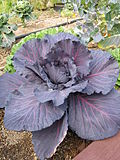Red cabbage
Red Cabbage (Brassica oleracea var. capitata f. rubra) is a type of cabbage that is purple or red in color. It is a member of the Brassicaceae family, which also includes broccoli, Brussels sprouts, and kale.
Description[edit]
Red cabbage is a biennial plant that is typically grown as an annual vegetable crop for its dense-leaved heads. The plant is characterized by its red or purple leaves, which are often used in salads and coleslaw. The color of the leaves can vary depending on the pH level of the soil in which the plant is grown. In acidic soils, the leaves will appear more red, while in neutral soils, they will be purple.
Cultivation[edit]
Red cabbage is a cool-season crop that prefers a well-drained, fertile soil with a pH between 6.0 and 7.0. It is typically direct-seeded or transplanted in early spring or late summer. The plant requires consistent moisture and regular fertilization to produce large, dense heads.
Nutritional Value[edit]
Red cabbage is known for its high nutritional value. It is rich in vitamin C, vitamin K, and fiber. It also contains significant amounts of anthocyanins, a type of flavonoid that gives the cabbage its red color and has been linked to a variety of health benefits, including reduced risk of heart disease and improved cognitive function.
Culinary Uses[edit]
In addition to being consumed raw in salads and coleslaw, red cabbage can be cooked in a variety of ways. It is often braised or roasted and served as a side dish. It can also be pickled or fermented to make sauerkraut. In many cultures, red cabbage is a traditional ingredient in holiday dishes.
See Also[edit]
-
Brassica oleracea var capitata Rubyball
-
Field with red cabbages
-
Purple cabbage
-
Red cabbage with horizontal cut through its growth axis
-
Extract of red cabbage in the beaker (pH indicator)
-
Red cabbage
-
Red cabbage (Brassica oleracea convar)
Ad. Transform your life with W8MD's Budget GLP-1 injections from $75


W8MD offers a medical weight loss program to lose weight in Philadelphia. Our physician-supervised medical weight loss provides:
- Weight loss injections in NYC (generic and brand names):
- Zepbound / Mounjaro, Wegovy / Ozempic, Saxenda
- Most insurances accepted or discounted self-pay rates. We will obtain insurance prior authorizations if needed.
- Generic GLP1 weight loss injections from $75 for the starting dose.
- Also offer prescription weight loss medications including Phentermine, Qsymia, Diethylpropion, Contrave etc.
NYC weight loss doctor appointmentsNYC weight loss doctor appointments
Start your NYC weight loss journey today at our NYC medical weight loss and Philadelphia medical weight loss clinics.
- Call 718-946-5500 to lose weight in NYC or for medical weight loss in Philadelphia 215-676-2334.
- Tags:NYC medical weight loss, Philadelphia lose weight Zepbound NYC, Budget GLP1 weight loss injections, Wegovy Philadelphia, Wegovy NYC, Philadelphia medical weight loss, Brookly weight loss and Wegovy NYC
|
WikiMD's Wellness Encyclopedia |
| Let Food Be Thy Medicine Medicine Thy Food - Hippocrates |
Medical Disclaimer: WikiMD is not a substitute for professional medical advice. The information on WikiMD is provided as an information resource only, may be incorrect, outdated or misleading, and is not to be used or relied on for any diagnostic or treatment purposes. Please consult your health care provider before making any healthcare decisions or for guidance about a specific medical condition. WikiMD expressly disclaims responsibility, and shall have no liability, for any damages, loss, injury, or liability whatsoever suffered as a result of your reliance on the information contained in this site. By visiting this site you agree to the foregoing terms and conditions, which may from time to time be changed or supplemented by WikiMD. If you do not agree to the foregoing terms and conditions, you should not enter or use this site. See full disclaimer.
Credits:Most images are courtesy of Wikimedia commons, and templates, categories Wikipedia, licensed under CC BY SA or similar.
Translate this page: - East Asian
中文,
日本,
한국어,
South Asian
हिन्दी,
தமிழ்,
తెలుగు,
Urdu,
ಕನ್ನಡ,
Southeast Asian
Indonesian,
Vietnamese,
Thai,
မြန်မာဘာသာ,
বাংলা
European
español,
Deutsch,
français,
Greek,
português do Brasil,
polski,
română,
русский,
Nederlands,
norsk,
svenska,
suomi,
Italian
Middle Eastern & African
عربى,
Turkish,
Persian,
Hebrew,
Afrikaans,
isiZulu,
Kiswahili,
Other
Bulgarian,
Hungarian,
Czech,
Swedish,
മലയാളം,
मराठी,
ਪੰਜਾਬੀ,
ગુજરાતી,
Portuguese,
Ukrainian







